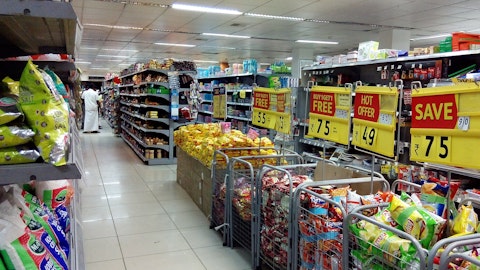Hormel Foods Corp (NYSE:HRL) is the most recent dividend king to be crowned. The company recently raised its dividend by 16%, marking its 50th consecutive dividend increase.

Any company that manages such an accomplishment is worth becoming familiar with, and HRL is no exception. The company has one of the safest dividends around and has grown its dividend by 18% per year over the last five years.
HRL is not very popular among the investors tracked by Insider Monkey. Out of more than 730 funds, just 15 reported long positions in HRL as of the end of September, down from 21 a quarter earlier. Moreover, these funds held just 1.10% of the company, according to the last round of 13F filings. Cliff Asness’ AQR Capital Management disclosed ownership of 1.51 million shares of HRL in its last 13F.
While we don’t yet own HRL in our Top 20 Dividend Stocks portfolio, dividend investors might want to keep an eye on the company for several reasons.
Business Overview
HRL has been in operation for 125 years and is a multinational manufacturer and marketer of consumer-branded food and meat products. Some of the company’s well-known brands include Skippy peanut butter, SPAM meat, Dinty Moore stew, Muscle Milk protein drinks, Wholly Guacamole dips, Jennie-O turkey, and numerous Hormel-branded products.
Roughly 53% of HRL’s products are perishable (fresh meats, frozen items, refrigerated meals, sausages, hams, guacamole, and bacon), 19% are poultry (Jennie-O turkey), 18% are shelf-stable (canned luncheon meats, microwaveable meals, stews, chilies, hash, tortillas, and peanut butter), and 10% are miscellaneous (nutritional food products and supplements, sugar, dessert mixes, and drink mixes).
Segments
Grocery Products (17% of sales, 20% profit): sells shelf-stable food products predominantly in the retail market (Walmart accounted for 14% of company-wide sales last year).
Refrigerated Foods (47% of sales, 38% profit): sells branded and unbranded pork and beef products for retail, foodservice, and fresh product customers.
Jennie-O Turkey Store (18% of sales, 28% profit): sells branded and unbranded turkey products for retail, foodservice, and fresh product customers.
Specialty Foods (12% of sales, 9% profit): sells private label shelf stable products, nutritional products, sugar, and condiments to industrial, retail, and foodservice customers.
International and Other (6% of sales, 8% profit): sales of HRL’s products in international markets such as China.
Business Analysis
Few companies survive for 125 years. HRL’s competitive advantages are not about patents (HRL only has 63) or innovation (HRL spent $32 million on R&D last year).
As one of the largest consumer-branded food and meat manufacturers, HRL’s key to success is favorably altering customers’ perceptions of its products to gain loyalty and market share. The company spent approximately $145 million on advertising last year, an amount nearly five times greater than HRL’s spending on R&D.
With many of its brands dating back over 50 years (e.g. SPAM and Dinty Moore were introduced in the 1930s) and supported by billions of advertising dollars over the years, consumers know and trust HRL’s products. As a result, more than 30 of HRL’s brands have #1 or #2 market share positions in their category.
Beyond brand recognition, retailer relationships, and shelf space market share, HRL also benefits from economies of scale. As one of the larger players in the market, HRL is able to achieve lower production costs than smaller rivals and squeezes more value out of each advertising dollar it spends by extending well-known brands into adjacent product categories. Extensive regulations by the U.S. Department of Agriculture also disadvantage smaller competitors.
HRL’s global distribution channels and economies of scale also help the company’s growth and diversification efforts. HRL has made several large acquisitions over the last five years to expand its business further beyond meat products. It acquired sports nutrition products company CytoSport for $450 million in 2014, Skippy peanut butter for over $700 million in 2013, and organic meat company Applegate Farms for $774 million in 2015. HRL can sell these new brands and products to its existing customers and improve the cost profile of each acquired company once they are integrated.
With the company’s mix of higher-margin products increasing, HRL recently boosted its company margins guidance from 9-12% to 10-13%. As long as consumers need to eat, HRL’s well-known brands will be there for them.
Follow Hormel Foods Corp (NYSE:HRL)
Follow Hormel Foods Corp (NYSE:HRL)
Receive real-time insider trading and news alerts





